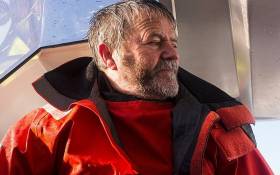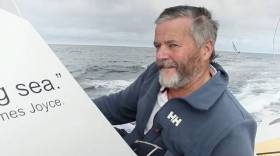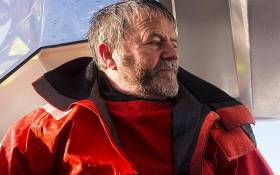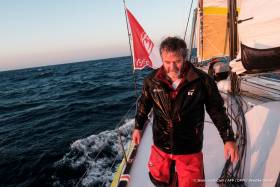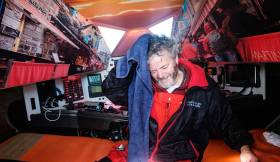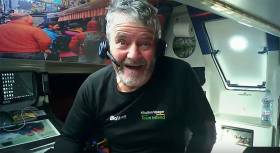Displaying items by tag: Vendee Globe
New Initiative to Nurture a British Vendée Globe Winner
Launched in 2016, Vendée2020Vision is a new initiative to support British sailors along the path to success in yacht racing’s most challenging event - the Vendée Globe, the quadrennial singlehanded non-stop round the world race.
Singlehanded offshore racing is an endurance sport that for participants is the toughest discipline in sailing. It has created many British legends from early pioneers such as Sir Francis Chichester, Sir Robin Knox-Johnston and Sir Chay Blyth to contemporary figures such as Dame Ellen MacArthur, Pete Goss, Mike Golding, Sam Davies, Dee Caffari, Brian Thompson and Alex Thompson. It is a sport that was created in Britain, inspired by the early round the world record breakers and the establishment of events such as the OSTAR and the Mini Transat in the 1960s and 70s. But since then France has completely dominated the sport.
Currently the Vendée Globe is the pinnacle event in the solo offshore racing calendar. British solo sailors have competed in all but the first race in 1989-90, with Dame Ellen MacArthur holding the record for the best British result when she finished a close second in 2000-1. British entries in the race peaked in 2008-9 when seven skippers from the UK entered, but in the current race, which set sail from Les Sables d’Olonne in November, there is just one – Alex Thomson sailing Hugo Boss.
Created by Southampton-based yacht racing management company Whitecap and supported by Artemis Investment Management LLP, Vendée2020Vision is seeking to rejuvenate British participation in the solo non-stop round the world race. This it intends to do not only by helping aspiring British singlehanded offshore sailors fill in the gaps in their skill sets, both at sea and in raising funding on land, but also approaching the problem from the opposite angle: Encouraging corporate Britain to get behind its worthy initiative.
Simon Clay, CEO of Whitecap commented: “Through Vendee2020Vision, British singlehanded offshore sailing has a huge amount to offer a commercial partner. We are working with some exceptional youth talent, nurturing their potential with the belief that we can achieve the first British winner of a solo non-stop around the world race for over 50 years in 2020. We believe also that in this age of digital and social media we have an offering that competes favourably in the advertising and sponsorship marketplace. We have the ability to create compelling and authentic content portraying strong human and brand values in abundance.”
In its first year, Vendée2020Vision has provided training to aspirant competitors Andrew Baker, Conrad Manning, Henry Bomby, Jack Bouttell, Lizzy Foreman, Nikki Curwen, Robin Elsey, Sam Goodchild, Sam Matson and Will Harris, the majority graduates of the Artemis Offshore Academy.
On the water, these sailors have had the opportunity to train and compete on the Artemis Ocean Racing IMOCA 60 yacht, which British sailor Jonny Malbon raced in the 2008 Vendée Globe and which Whitecap has managed for the last 5 years. Whitecaphas enlisted as Vendée2020Vision’s lead coach, Dee Caffari, the only woman to have sailed round the world singlehanded in both directions as well as being a past Vendée Globe and Volvo Ocean Race competitor.
Vendée2020Vision sailors have had the opportunity to participate on training days with Dee to learn the ropes on the Artemis Ocean Racing IMOCA 60 – a significant step-up from the 32ft long Beneteau Figaro 2s and 21ft Minis they have been used to. IMOCA 60s are custom boats (ie each is different), and are technically much more complex with canting keels, daggerboards, kick up rudders, intricate electronics, etc. Compared to Figaros, they are also giant boats: Almost twice as long, their mast twice as high, and with a sail area some five times larger - much closer to the limit of what a solo racing sailor can physically operate. As a result different techniques are required to sail them.
In 2016, Vendée2020Vision sailors competed on the IMOCA 60 in 3,000 miles of Royal Ocean Racing Club offshore events. This culminated in them winning the club’s Canting Keel Class trophy for the season.
The reason British competitor numbers in the Vendée Globe are dwindling is due to the sailors being unable to raise adequate backing and corporate Britain being unwilling to release its purse strings. Through its Vendée2020Vision initiative, Whitecap is working hard on both sides of this equation.
To improve their chances in the board room Vendée2020Vision sailors have had the opportunity to take part in 12 bespoke training modules that have included networking and pitch development coaching. The sailors have then had the opportunity to prepare themselves for boardroom scrutiny by testing their pitches. This they have done in a Dragon’s Den-style ‘real’ environment, presenting to executives from Harrods and clients from accountants Grant Thornton, who have then provided their feedback.
Vendée2020Vision provides commercial support to sailors giving them the best chance of raising funds for their own campaigns, with Whitecap able to offer the added benefit of being able to take potential sponsors sailing on an IMOCA 60.
In conjunction with this, Whitecap is undertaking its own independent sponsorship search, spelling out the benefits of backing Vendée Globe campaigns to companies both in the UK and abroad. With the aim of casting their net wide, they have been working with leading media agencies and running advertising campaigns to promote British participation in the Vendée Globe in the Financial Times, the Financial Technologist and Harrods media.
Throughout 2016, the Vendée2020Vision sailors have been scored by a team including Whitecap’s Commercial Manager Sean Woods and Sponsorship Manager Jess Dahlgren. Based on the outcome of the 2016 results, the sailors are being whittled down to six this year. Ultimately the top two will get the opportunity to compete aboard an IMOCA 60 in the Rolex Fastnet Race and subject to funding, the doublehanded transatlantic race, the Transat Jacques Vabre in autumn 2017.
#VendeeGlobe - Enda O’Coineen says “it's a real possibility to finish what I started” despite the devastating mast break that took him out of the Vendée Globe on New Year’s Day.
The Kilcullen Voyager helm was forced to cut the rig free to protect the hull after dismasting some 180 nautical miles south-east of Dunedin in New Zealand — ending Ireland’s first ever challenge in the round-the-world solo yacht race at the half-way point.
In his final race log, the 60-year-old businessman described how the incident left him “shaken and struggling to get back to New Zealand”, with no motor on board and many miles from rescue.
However, 40-knot winds over the last few days helped to push his drifting vessel into range of a Dunedin trawler, on board which he was expected to reach land this morning (Friday 6 January).
Speaking to the Press Association ahead of his arrival, he confirmed comments from his last log that he wants to complete the race course, even if he is formally out of competition.
"It's a real possibility to finish what I started but it's a massive undertaking to do the repair," said Afloat.ie’s Sailor of the Month for December. "But I'm nervous about saying I'm going to do that.
“Doing that, resourcing it, making it happen, there's a lot of sacrifice for the family and all of that but that's one real alternative I'm contemplating."
Replacing the rig is one of three options open to O’Coineen, which include shipping the broken boat home, or leaving it behind.
Enda O'Coineen is Sailor of the Month for December
For months now, Enda O Coineen’s campaign in the Vendee Globe with the veteran IMOCA 60 Kilcullen Voyage has captured public imagination as the resilient 60-year-old lone sailor has battled the challenge of a lifetime in the most demanding sailing event in the world. By December, his progress had become a part of everyday life for his thousands of followers in Ireland and abroad. Far from being a dogged account of endless struggles with ferocious weather and the inevitable gear failure, his reports were often laced with lively humour, unflinching self-analysis, and the occasional highly entertaining declamation of poetry in mid-ocean.
As December progressed, his placing in the race continued to improve as others of the 29 starters fell by the wayside. It was becoming increasingly likely that if he eventually made it to the finishing line in Les Sables d’Olonne, he would have got into single figures on the leaderboard. December 9th was surely the highlight, when he logged 395 miles in a single day. But then, following a complete knockdown, one problem after another followed, and he’d to divert to Stewart Island off the southern tip of New Zealand for a day’s shelter and essential repairs.
The jobs done, he was on his way again as December drew to a close when a sudden squall from a new direction and a self-steering malfunction caused a couple of crash gybes, the second resulting in a total dismasting with the entire rig having to be cut away in violent seas. Eventually, resorting to engine power soon resulted in a stray rope jamming the propeller. Yet with a jury rig using spare mainsail battens as masts, he has been able to make his way unaided back towards New Zealand, where he will be brought into port with a pre-arranged tow from a fishing boat.
His spirit in the midst of these setbacks is reminiscent of Ernest Shackleton at his best. We’re well aware that a year ago, we made Enda O’Coineen January “Sailor of the Month” for his success in qualifying for a place in the Vendee Globe thanks to a third place in December’s Transatlantic Race. But his unsinkable spirit deserves a second award as our final gesture to what he has achieved in 2016.
Ireland's Vendee Globe entrant Enda O'Coineen is shaken after being dismasted and struggling to get back to New Zealand with no engine (a rope around the prop), it means he could be many days to get in range for a tow...here's his final race log
For New Year's Day we had an interesting Log ready to go. It included resolutions to take less risk with life, The Pacific Ocean, looking forward to Cape Horn - and delectably delighted to be back in the Vendee after a hard 3 weeks in the Indian Ocean.
Then 'wham' and within a few hours the mast, and my dream came tumbling down. Fortunately I slashed away the rig to avoid it making a hole in the boat and am now secure, battered, cold, wet and isolated, miles from anywhere… And while I need help, I have been carefully not to call the rescues services.
It was a sudden 35 knot squall and a series of involuntary gybes - as the boat self-steering at a critical time went out of control - which caught us without a backstay runner and not enough support for the mast. This should not have happened. However I took the risk, its my responsibility and I am heartbroken for all who have supported the challenge. Thanks.
Now 36 hours later I am still shaken and struggling to get back to New Zealand and no motor (a rope around the prop) it could be many days to get in range for a tow - meanwhile we have plenty of food and are secure on the mastless boat.
What does all this mean? Clearly I am out of the race and I would like to thank the Vendee Race Office for a great job and the on-going support of Marcus Hutchinson and Neil O'Hagan - also John Malone who put in an all-nighter to help fix us off Stewart Island.
On personal basis I will get back to individual supporters. In particular thanks to Invivo /BIOLINE. Most important, I would like the MSL Mercedes Schools Programme to continue following the Vendee. There is great content and there are still several other good boats and skippers still on the track to get behind.
Also I ask that all continue to support the ATLANTIC Youth Trust's charity to connect youth with the ocean, and adventure. Its 30 year mission is clear and we need to invest in the future.
For the Kilcullen and her sad Skipper, first we must get to land safely.
Then it's either one of three scenarios: 1) find another mast and sail back to Les Sables and complete the singlehanded circumnavigation 2) Leave the boat in New Zeeland and find another challenge or 3) Ship it back to Europe. It's all too soon to decide and work out but most important is to get back to family, friends and back to work and a 'normal' life - whatever that is...
On reflection, 0100 hrs., Jan 1st 2015, - had I not made that fateful Call at a New Years' Party to Mike Golding to buy the Kilcullen Voyager on the phone it would not have happened.
"Will I or won't I"?
And, with the logic that if you think too much about doing something you'll never do it -and the support of The Lady Nicola "Go on says she" I called Mike. Fortunately he had not gone to bed and I was distressingly sober.
There and then, agreed the price and did the deal. Like marriage, for better or worse.
The acquisition was in anticipation of the Vendee, however it would be over another year before I committed to the race. I was afraid, in awe of the power of the boat, and nervous that I could never sail her.
And now, exactly 2 years later, having mastered the boat, a trans-Atlantic Race podium, qualified, up and down to the Canaries, around Ireland and sailed half way around the planet at least something has 'happened'
To wrap, now I am a bundle of emotion, trying to figure out what it all means - heartbroken and devastated.
But this is a 'First World' problem. I am lucky to have had the opportunity and for the wonderful friends, family and people whom I have not met who have given and shown wonderful support in celebrating life, adventure, the environment, the ocean and our planet.
Thanks from the bottom of my heart - and this is the last Log and you will be spared the trial and tribulations of the challenge now to get to a safe port and work it out.
Happy New Year, Lets make it a good one - but move away some from "The Edge" - its crowded.
Enda O'Coineen Dismasted, First Irish Vendee Globe Challenge is Over (Update at 1600hrs)
Enda O'Coineen has been dismasted on New Year's Day off New Zealand bringing to an end Ireland's first ever Vendee Globe Challenge at the half way stage of the solo round the world race.
O'Coineen reported to Race Headquarters in Paris at 0830hrs UTC that the mast of Kilcullen Voyager - Team Ireland has broken.
Over the past 55 days Enda has sailed 13,153 nautical miles (over 24,000 kilometres) alone, through some of the worst weather imaginable. He has overcome rigging issues, electrical issues, the mental challenge, but losing the mast is something impossible to repair.
His position is now some 180 nautical miles to the south east of Dunedin, New Zealand. He was racing in 35kts of SSE wind when the rig broke. The skipper is uninjured and reported that he was starting to secure his boat and the broken pieces of the rig and planned to head to New Zealand which, in the current weather situation, is downwind for him. He should have enough fuel on board for the journey.
Enda is in contact with the Technical Team and Race Direction. A full assessment of his situation is being made and more details will follow.
Update at 1600hrs
In a few unfortunate moments the Vendée Globe solo round the world race came to a premature end for Irish skipper Enda O'Coineen. A sudden, unexpectedly strong gust at 35kts of wind overpowered his autopilot, resulting in two crash gybes leaving no time to get a running backstay on to support the mast.
In seconds the mast of Kilcullen Voyager-Team Ireland is broken, falling over the side of the boat.
Lying in 15th place in the famous round the world race, which represented the pinnacle of his lifetime of sailing and adventuring, O'Coineen had only just completed a series of necessary repairs 24 hours earlier, whilst sheltered in the lee of Stewart Island, at the very southernmost tip of New Zealand. Ironically only two hours previous to his mast crashing down, he had made a New Year's video, promising to recalibrate his natural affinity for risk.
Having just effected his repairs – principally to his autopilot and computers - and actually having profited from his experiences and his solid speeds in the Indian Ocean, O'Coineen today spoke of his deception and disappointment, which are felt all the deeper and harder because he considered himself to be in good shape to take on the second half of his round the world race:
“I am devastated. Things were going quite well. O'Coineen said, “I was in good shape. Having got this far I felt we could handle anything. There was just that little malfunction of the self-steering that set a whole train in motion. I have to accept responsibility. What happens, happens.”
In terms of his Vendée Globe, setting out on the 5,000 miles to Cape Horn, O'Coineen, 60, is fortunate to have been a little less than 200 miles SE of Dunedin when his mast came down. He cut is rig free but reported that he did not save the boom, or any part of the mast, and so has very limited jury rig options. He was heading slowly downwind towards New Zealand this Sunday afternoon.
“You roll the dice.” He told Race HQ in Paris after prefacing his description of the incident by wishing all a Happy New Year. “I was caught a little bit unawares. I was in 20-25kts of breeze and a very vicious 35kts squall came through and the self-steering malfunctioned just at the wrong moment. I did an involuntary gybe and then a gybe back. The boat was out of control and I was caught without the runner properly on and the mast snapped. I have to laugh because if I don't I will cry. The mast came clean off at the deck and in fact it was intact. But the whole rig went over the side. I had the difficult decision to make whether to try and save the rig or whether to save the hull of the boat.”
O'Coineen's humour, philosophy and his larger than life character, his predilection for wearing his big and passionate heart on his sleeve will be missed over the remaining weeks of this Vendée Globe.
“Look, you have to be philosophical. This sort of sailing is living on the edge. I have been doing this for 57 days and as the fella says if you are living on the edge you are taking up too much space. I was taking up too much space on the edge.”
“Ironically I had just done a little interview with myself for New Year. I celebrated with a small bottle of champagne. My alter personality asked me what my New Year's Resolution is. And my New Year's Resolution was to take less risk with my life. In business, in my life, I have taken a lot of risk. The risk enabled me to make enough money to buy this boat, to pursue the dream and to pursue my adventure. Bizarrely, only two hours earlier, I had recorded a video pledging to take less risk. And here I am. Risk is a four letter word, like a lot of meaningful four letter words in the English language.”
Of the 18 boats still actively racing, 29 having started in Les Sables d'Olonne on November 6th, some eight weeks ago, the leadership battle sees Armel Le Cléac'h having gained 43 miles in the 24 hours to 14:00hrs UTC. Second placed Alex Thomson (Hugo Boss) will seek to minimise his time upwind on port tack because he has no foil to provide lift and traction.
Transcript from Enda onboard Team Kilcullen:
"You roll the dice. I was caught a little bit unawares. I was in 20-25 kts of breeze and a very vicious 35kt squall came through and the self-steering malfunctioned just at the wrong moment. I did an involuntary gybe and then a gybe back. The boat was out of control and I was caught without the runner properly on and the mast snapped. I have to laugh because if I don't I will cry. The mast came clean off at the deck and in fact it was intact. But the whole rig went over the side. I had the difficult decision to make of whether to try and save the rig or whether to save the hull of the boat. I thought of safety first. I cut the rig free from the boat. I was worried that the stump of the rig would hole the boat. The seas were pretty wild. There was a big sea running. I cut the entire rig free. I am mastless, the deck was holed. It is not a happy situation but there it is, you roll the dice. That is the risk you take.
I am devastated. Things were going quite well. I was in good shape. Having got this far I felt we could handle anything. There was just that little malfunction of the self-steering that set a whole train in motion. I have to accept responsibility. What happens, happens.
Look, you have to be philosophical. This sort of sailing is living on the edge. I have been doing that for 57 days and as the fella says if you are living on the edge you are taking up too much space. I was taking up too much space on the edge.
Ironically I had just done a little interview with myself for New Year. I celebrated with a small bottle of champagne. My alter personality asked me about my New Year's Resolution. And my New Year's Resolution was to take less risk with my life. In business, in my life I have taken a lot of risk. The risk enabled me to make enough money to buy this boat. to pursue the dream, to pursue my adventure. The irony is that only two hours earlier I had recorded a video to pledge to take less risk. And here I am. Risk is a four letter word, like a lot of meaningful four letter words in the English language.
What can you do? I have acted responsibly.
It is January 1st. It is a New Day and a New Year and it is time to move on. My Vendée Globe is over. I am appreciative of all the support I have had. "
Enda O'Coineen Diverts in Vendee Globe For 'Major Issue' Repairs
Enda O'Coineen has had to take the prudent, but tough decision, to turn back north in the Vendee Globe Race and separate away from the six strong pack of boats he had been racing closely with, playing tag with the back of that same depression. O'Coineen is diverting to Stewart Island, just off the tip of South Island New Zealand in order to make repairs and continue his race.
O'Coineen, who was lying in 11th place of the 19 solo skippers still racing, is seeking to complete a number of repairs, and aims to continue with his race. Stewart Island, which is some 19 miles south of the tip of New Zealand's South Island, is famous in the history of the Vendee Globe as it is where legendary French skipper Yves Parlier stopped for ten days during the 2000-1 edition of the race and repaired his broken mast with no outside assistance, before restepping it using his boom as a derrick.
None of O'Coineen's problems aboard Kilcullen Voyager-Team Ireland, in isolation, are considered race ending in themselves, but together they might endanger him during the 5000 miles between New Zealand and Cape Horn. Following the rules and spirit of the race, the intention of the Irish soloist is to complete his repairs unassisted and to continue racing. He spoke today of losing 'a couple of days'. The solo skipper has a NWW'ly wind of 25-30kts and is expected to arrive at Stewart Island some time late Thursday or early Friday.
O'Coineen said this afternoon: “It is really the accumulation of three weeks going through the Indian Ocean. I have had several small problems and together they have become a big problem. I have a problem with the self steering and with the mast track and with the communications and so I have made the very difficult decision to stop. I am not stopping the race. I will just make the repairs under my own steam. It was a choice between Campbell Island which is close to me (now) or Stewart Island which is to the south of New Zealand. It is a better anchorage and I don’t have much detail on Campbell Island. I was enjoying the race, getting up to 10th or 11th place, but now if I lose a couple of days I will lose a couple of days, but hopefully I will be able to effect these repairs. It is a good long haul to Stewart Island. In one sense I could have continued into the Pacific and to Cape Horn but this is my last jumping off point, so it would have been a huge risk. In the meantime I am doing what is the more prudent, seamanlike thing to do. I am torn apart with it. It is cold and wet and it is the middle of the night right now. It has not been a good day. That is what the challenge is. It will be a big job to do the repairs on my own but hopefully I can do that."
"It is an awful shame to be going there (Stewart Island) and not to stop for any length of time (laughs) but maybe there may be bonus there. We will be back soon. Hopefully we can make it all happen. The self steering system has to be recalibrated. The software is corrupted. I have to go to flat water. That is the first thing. At the spreader level I have a piece of the mast track which is broken about 18 inches. (45cms) The third main thing is when my reef broke I crash gybed and the lazyjacks broke. So to replace the mast track I have to climb the mast. I am making progress with the comms. So none of them alone is life threatening but the accumulation together is all pretty serious. But going into the Pacific this is my last place to undertake these repairs. So it is a big work load. There are some major issues to deal with.”
Thomson Rounds Cape Horn on Christmas Day
British Skipper Alex Thomson has rounded Cape Horn, an infamous milestone in the Vendee Globe, the solo, non-stop, around the world race. Thomson reached Cape Horn today at 11:42 UTC, arriving at the southern tip of Chile in 48d 23hrs 40mins, 1d 23hrs 8mins behind leader Armel le Cleac’h. Thomson’s time to Cape Horn beats the previous record set by Francois Garbart in the 2012-2013 edition by 3d 6hrs 10mins. This is the first time in the race’s history that skippers have rounded this landmark by Christmas.
Thomson is still in second place, 454 nautical miles behind Frenchman Armel le Cleac’h. The rivals have been battling for first place since the start of the race on the 6th November.
Cape Horn is such a renowned milestone for offshore yachting as it’s the point where the skippers turn the bow north again and begin their journey back through the Atlantic and heading towards home. Thomson and Le Clea’ch are expected to arrive at the finish port of Les Sables d’Olonne, France in mid January.
The Vendee Globe takes place every four years and has historically been dominated by the French. This year’s edition sees 29 IMOCA 60s compete in the race, including Thomson, the British entry. Ireland is represented for the first time by Galway adventurer Enda O'Coineen.
The race is renowned for being one of the most gruelling sporting challenges left in the world. Just 71 of the 138 starters since the race’s inception, back in 1989, have successfully completed the race, and three have lost their lives. In this edition, currently 7 skippers have had to retire from the race.
Thomson is determined to be the first British skipper to win the race, which could take in the region of 80 days to complete.
Enda O'Coineen's Vendee Globe: The Big Boys' Compared To Sydney–Hobart
The 72nd Rolex-Sydney-Hobart gets under way on Monday. The Australian ocean classic is rightly regarded as a tough event. Yet in terms of the sailing challenges its poses, it seems to pale into insignificance when set against the Everest of ocean racing, the Vendee Globe. But W M Nixon wonders if it’s fair on either event to try to make meaningful comparisons.
Just ten days ago on December 14th, the IMOCA 60 St Michel-Virbac, racing in the Vendee Globe Race, came speeding through the Bass Strait between Tasmania and mainland Australia, eastward bound for Cape Horn. Her skipper Jean-Pierre Dick – who won the 2007-2008 Barcelona World race as co-skipper with Ireland’s Damian Foxall – was seeking some shreds of shelter from a huge storm raging in the Great Southern Ocean between Tasmania and Antarctica.
It is the first time in the history of the Vendee Globe that a boat has diverted so far north and used the channel between Tasmania and Australia. But then, under the ice-avoiding conditions stipulated for the current edition of the race, the whole fleet has probably been further north than it might have been in time past.
Be that as it may, when this race is over the analysts will debate whether or not St Michel-Virbac gained or lost from her tactic. For now, all we know is that she currently lies fourth overall, having moved up a place when the Marcus Hutchinson-managed Paul Meilhat of SMA had to pull out with a catastrophic keel mechanism ram failure on Wednesday December 21st. So the probability is that by easing up on the pressure, albeit briefly, St Michel-Virbac did herself no harm at all in the big picture.
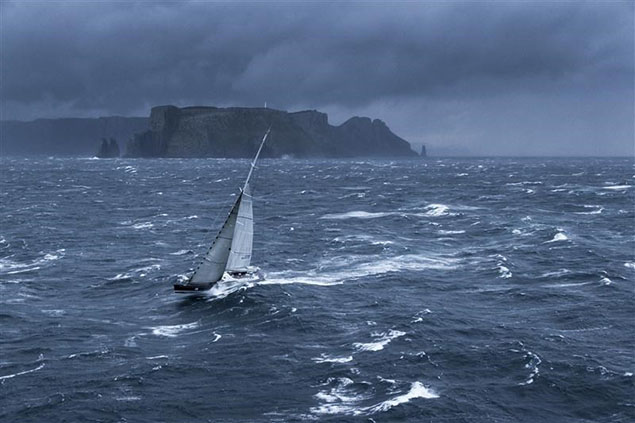 The waters of Tasmania in an unruly mood – the Swan 82 Nikata in the 2013 Rolex Sydney-Hobart Race. Photo Rolex
The waters of Tasmania in an unruly mood – the Swan 82 Nikata in the 2013 Rolex Sydney-Hobart Race. Photo Rolex
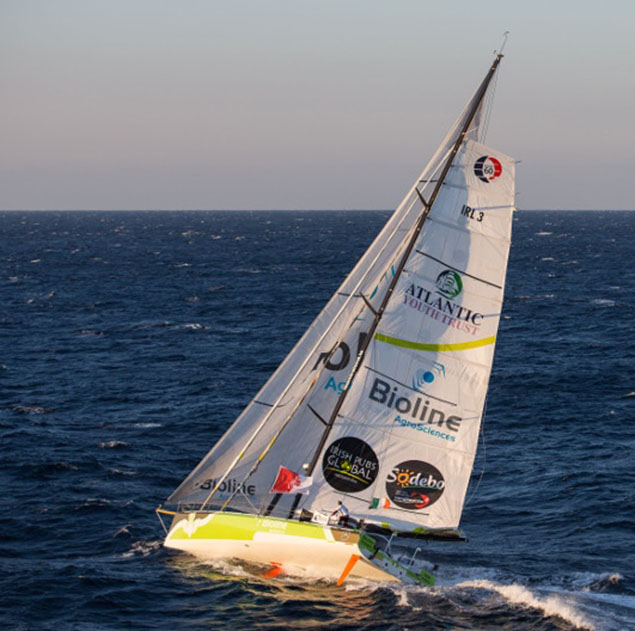 Kilcullen Voyager may look ultra-modern to many sailors, yet she’s a ten year old veteran which lacks the hydrofoils of the most modern boats. Photo Team Ireland
Kilcullen Voyager may look ultra-modern to many sailors, yet she’s a ten year old veteran which lacks the hydrofoils of the most modern boats. Photo Team Ireland
As for Marcus Hutchinson, his challenges these past few days have been prodigious. Not only is he Race Director for the SMA team, but he and his colleagues have been giving a friendly hand to the much less heavily-resourced Team Ireland campaign which is doing what it can to keep the Enda O Coineen show on the road with the ten-year-old Kilcullen Voyager.
In fact, the two boats are light years apart, as SMA is one of the newest boats with hydrofoils (all five current leaders are so equipped, even if second-placed Alex Thomson Hugo Boss has lost his starboard foil), whereas Kilcullen Voyager is an old Mike Golding warhorse which has been round the block and then some.
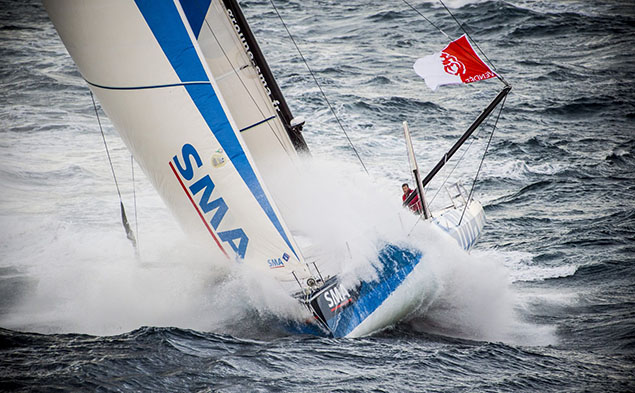 Paul Meilhart’s SMA has Marcus Hutchinson as Race Director, but after a very successful first half of the Vendee Globe, Meilhart is now out with a failed keel ram. Photo: Vendee Globe
Paul Meilhart’s SMA has Marcus Hutchinson as Race Director, but after a very successful first half of the Vendee Globe, Meilhart is now out with a failed keel ram. Photo: Vendee Globe
Yet now SMA is out of the race and the problem is to provide a rendezvous for her with a replacement keel ram which can be modified to fit her particular setup. But the doughty 60-year-old Enda O Coineen is still on track and moving steadily up the rankings despite setbacks which would have put many others out of contention.
The risks he’s had to take to keep it going defy the imagination. A sheet got well and truly fouled around one of his twin rudders, which meant he had to set the boat sailing on track such that the rudder was clear of the water on the weather side, and then he’d to clamber over that same wet and heaving side of the boat and perch on the rudder while he cleared the line.
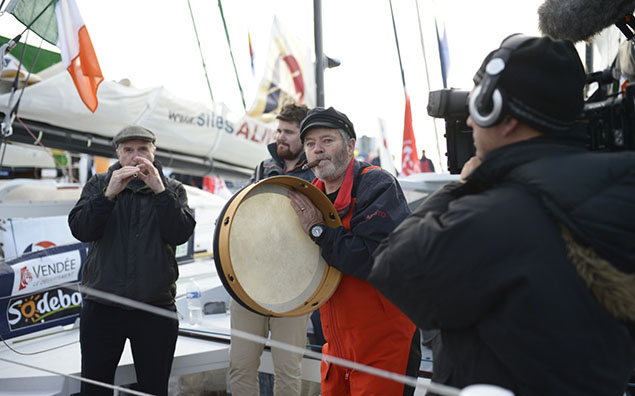 The party animal….Enda O Coineen with bodhran and cigar in Les Sables d’Olonne before the start
The party animal….Enda O Coineen with bodhran and cigar in Les Sables d’Olonne before the start
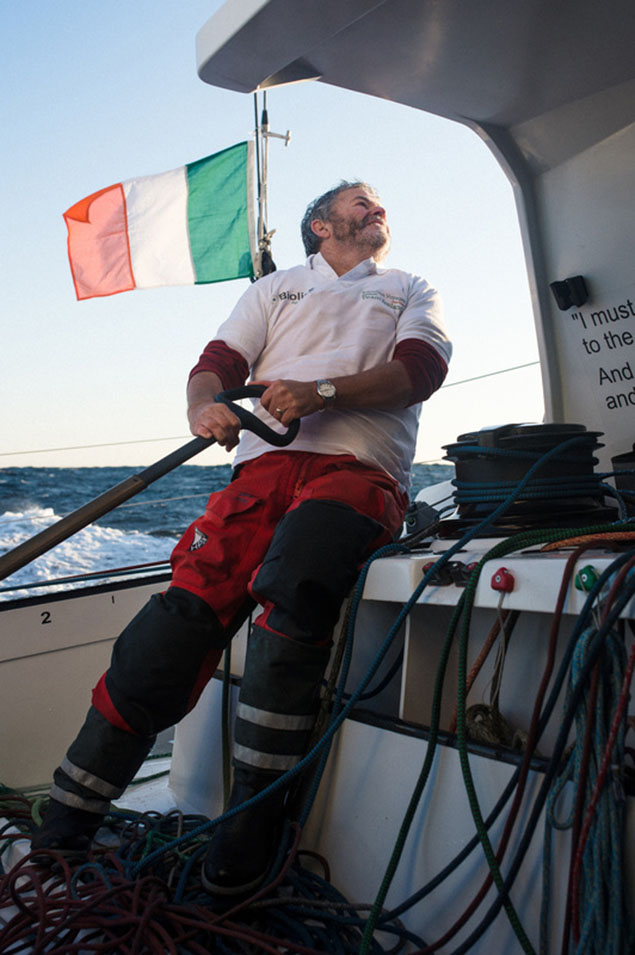 On his own, but the going is good. Enda O Coineen aboard Kilcullen Voyager getting the sort of sailing most of us dream of.
On his own, but the going is good. Enda O Coineen aboard Kilcullen Voyager getting the sort of sailing most of us dream of.
Even he admitted that he suffered a bit of a reaction to the all-or-nothing situation he had been in once he got safely back on deck. But since then his race has literally entered a darker phase as a massive knockdown has blanked out much of his electronics and knocked out his computer with the screen filled with water.
Even ashore in a fully-equipped workshop you’d be hard put to set that right. But in washing machine mode at top cycle, it’s a genius-defying predicament, yet his main men on land - Neil O’Hagan with Marcus Hutchinson - are doing everything possible while Marcus at the same time is seeing through the support programme for Paul Meilhart and the crippled SMA.
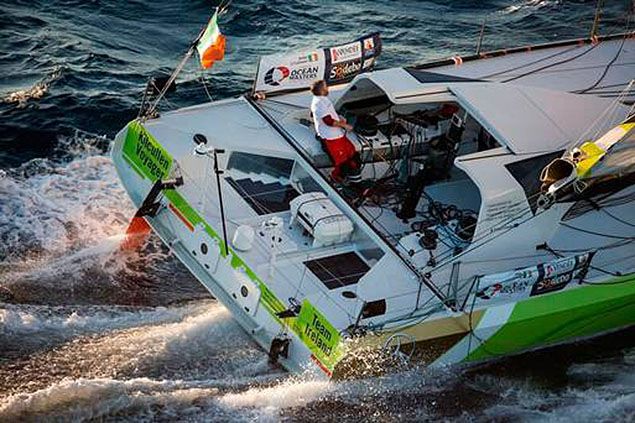 Aboard Kilcullen Voyager, the lone skipper has had a best day’s run of 395 miles. But now after electronic damage following a knockdown, he is back to basics with a small GPS and paper charts.
Aboard Kilcullen Voyager, the lone skipper has had a best day’s run of 395 miles. But now after electronic damage following a knockdown, he is back to basics with a small GPS and paper charts.
For Enda, it has been back to paper charts, a small GPS, and eyeball navigation with very red eyeballs. But by yesterday he was south of Australia, lying 13th overall out of 29 starters, and later today he hopes to be passing well south of Tasmania. Meanwhile in Sydney the crew of 88 boats will be having very controlled Christmas festivities as they keep themselves in competition-ready condition for the lunchtime start of the Rolex Sydney-Hobart Race on December 26th, with Tasmania and the Bass Strait very much in mind.
Back on December 14th, it was difficult to resist the temptation to draw smart-ass comparisons between the fact that a single-handed skipper racing in the Vendee Globe came whizzing through the Bass Strait for a brief experience of easier going, yet just two weeks later the crews the Hobart dash – the 72nd - reckon they’re the hard men (and women), and then some, to be facing into the crossing of the same Bass Strait.
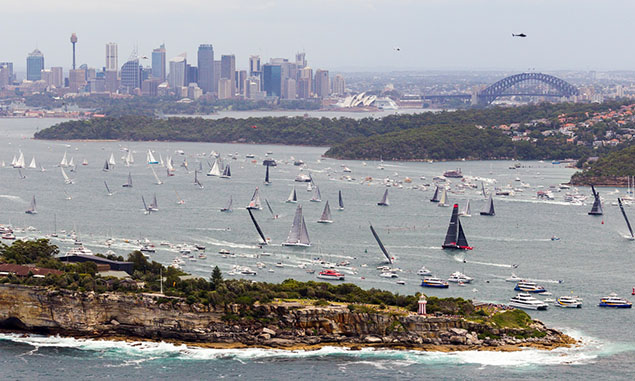 It’s an evocative part of world sailing’s fabric – the classic start of the Rolex Sydney-Hobart Race, down the harbour and out into the Tasman Sea. Photo Carlo Borlenghi/Rolex
It’s an evocative part of world sailing’s fabric – the classic start of the Rolex Sydney-Hobart Race, down the harbour and out into the Tasman Sea. Photo Carlo Borlenghi/Rolex
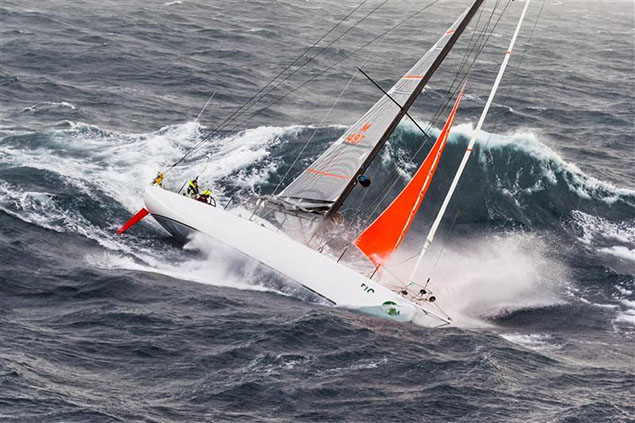 The race to Hobart as popularly imagined – slugging it out across the Bass Strait. Photo Rolex
The race to Hobart as popularly imagined – slugging it out across the Bass Strait. Photo Rolex
But apart from the geographic proximity, comparisons are scarcely valid. The Rolex Sydney-Hobart Race is a 630-mile sprint in which mostly amateur crews endure oceanic conditions of all kinds for a relatively brief period of sometimes very scary stuff, knowing that at any time a port is within a day’s sail provided their boat hasn’t been totally incapacitated.
That said, people have been lost racing to Hobart, with six being drowned in 1998’s race when a storm swept through the Bass Straits. But it was a disaster from which much was learned and is unlikely to be repeated, even though the sudden changeability of the weather in the course region, despite it being the Australian summer, is something more extreme than in most European experience.
Nevertheless, the Vendee Globe, despite its huge media machine and technically savvy shore support teams, ultimately comes down to just one lone sailor racing an enormous and demanding machine with sails of a size which in times past would have been considered unthinkable as a solo command.
Admittedly when in the region of Tasmania, these skippers are mostly sailing downwind, whereas the crews racing to Hobart can expect a windward slugging match. But in the mighty flowing tapestry which is the weather of the Great Southern Ocean, every so often the approach of yet another low pressure system will force the Vendee Globe Skippers to put in some harsh windward work before the fronts sweep through and they can get back to the business of fast offwind sailing which recently has seen the race leaders pass Point Nemo, that imaginary spot in the Southern Ocean way south of the Pacific which is the furthest possible point on the planet from the nearest land – 1,670 miles.
That’s a helluva sight further from the nearest land than you’ll be when sailing in the Bass Strait, where Jeanne-Pierre Dick reported on his culture shock - after so many days of lone sailing on open ocean - at seeing evidence of habitation in the form of wind turbines. With all due respect to the skipper of St Michel-Virbac, most of us experience culture shock at seeing a formerly-beloved landscape suddenly polluted with wind farms, but we know what he meant.
Be that as it may, the very thought of Point Nemo is enough to give your ordinary human being the frights, but the Vendee Globe racers have to take it in their stride, in fact they scarcely notice it as the main points are the real land ones, with Cape Horn in all its notorious glory now coming centre stage.
On Monday, there’ll be 88 boats coming centre stage in the natural amphitheatre of Sydney Harbour, and with the time of year that’s in it, the Rolex Sydney-Hobart Race is one of the most keenly-followed sailing classics in the world for the simple reason that most of the world’s sailing population lives in the northern hemisphere, and it offers a wonderful escape from the rigours of a winter Christmas.
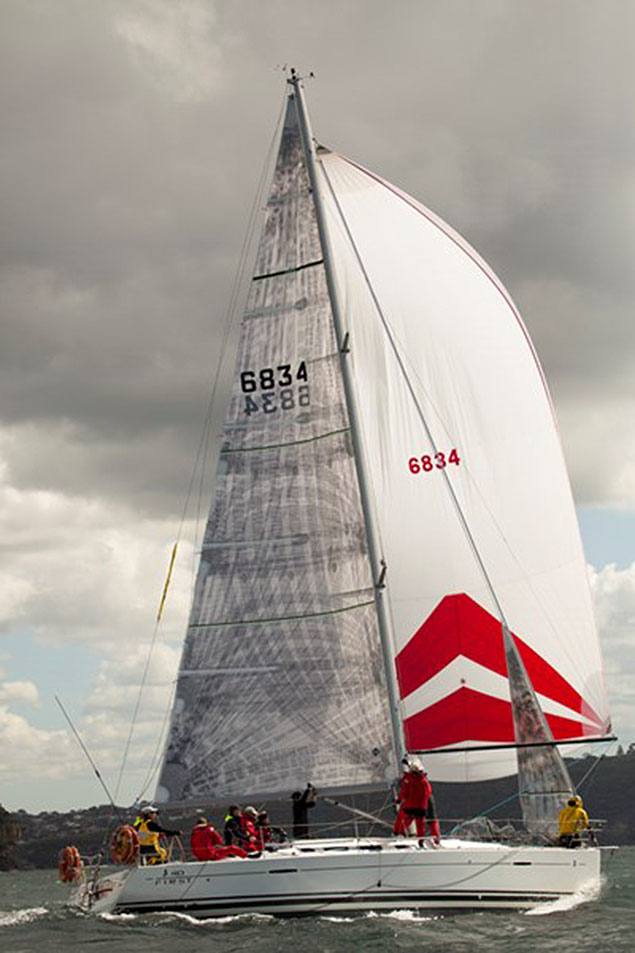 The First 40 Breakthrough will have Ireland’s Barry Hurley as Sailing Master in Monday’s Rolex Sydney-Hobart Race
The First 40 Breakthrough will have Ireland’s Barry Hurley as Sailing Master in Monday’s Rolex Sydney-Hobart Race
There’s considerable Irish interest – after all, ex-Pat Gordon Maguire has won it twice – but as well there’s a natural fascination with the comparision of the performance of different boat types in what amounts to full-size laboratory conditions.
Last time round, Maguire’s owner Matt Allen put himself in the tricky position of having to choose at the last minute between taking his Carkeek 60 Ichi Ban or his TP 52 of the same name – both were race ready with days to go. In the end they plumped for the Carkeek, and she had a reasonably good race. But the irony of it all was that the overall winner was the 2008-vintage TP 52 Balance, owned by Australia’s popular financial guru Paul Clitheroe.
He’s probably extra-busy these days guiding people through Australia’s current mini-recession, which has the entry down to 88 boats. If this trend continues, in the foreseeable future the Volvo Round Ireland Race, with its entry numbers rising to 63 in 2016, could be matching the Rolex Sydney-Hobart in fleet size, which really would be one for the books.
But that’s another day’s work. Right now, we can find Irish interest in Sydney in Gordon Maguire as sailing master aboard the TP52 Ichi Ban, in Barry Hurley of Malta but still Royal Irish YC in his CV as Sailing Master of the First 40 Breakthrough with Kenneth Rumball in the crew, and in Shane Diviney, originally of Howth but getting up to speed these days with the professional multi-hull scene Down Under, who is a crew-member aboard the successful Judel Vrolik 62 Chinese Whispers.
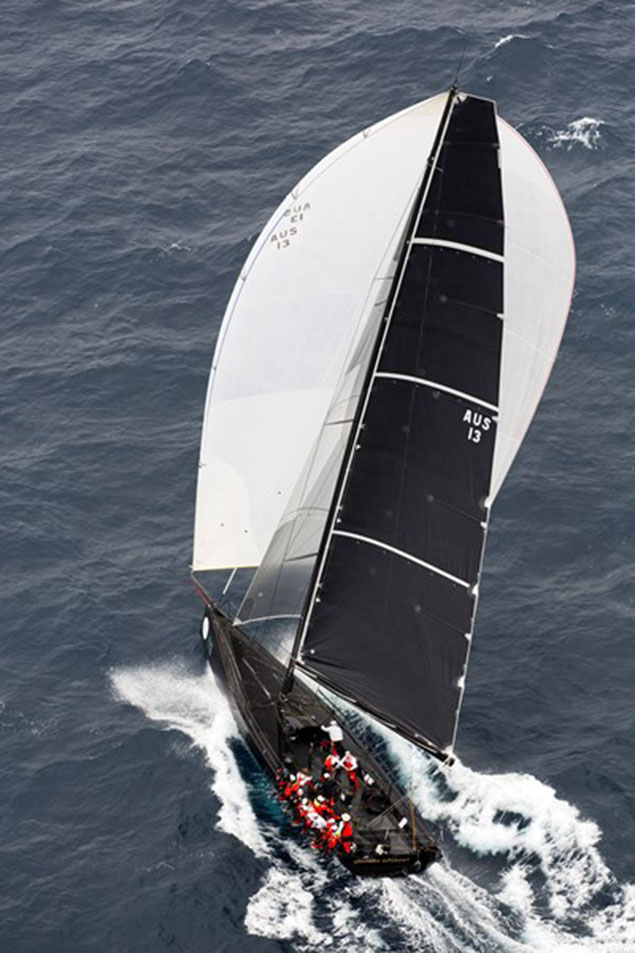 The successful JV62 Chinese Whispers has Ireland’s rising star Shane Diviney in her crew for the Rolex Sydney-Hobart Race.
The successful JV62 Chinese Whispers has Ireland’s rising star Shane Diviney in her crew for the Rolex Sydney-Hobart Race.
This is a boat which started life as Jethou purely for day racing at European venues, yet in Australia has proven to be a formidable performer offshore. As for others whose presence we might have expected, ace navigator Ian Moore – whose overall victory in the Middle Sea Race made him one of our “Sailors of the Month” in October – is taking a break to immerse himself in a family Christmas in Cowes after probably his most successful year ever, while for the rest of us the Rolex Sydney-Hobart Race will be a colourful interlude in the midst of the continuing mega-drama of the Vendee Globe.
Yesterday in this big one, the leader Armel Le Cleac’h rounded Cape Horn at 1234 UTC in Banque Populaire VIII with 595 miles in hand on the second-placed Alex Thomson in Hugo Boss. This margin may sound, well, it sounds stupendous – it’s just 35 miles short of the complete length of the Rolex Sydney-Hobart Race. But then the Vendee Globe is stupendous, and the men in it have shown themselves to be both superhuman and yet very human indeed.
 Banque Populaire VIII rounded Cape Horn at 1234 UTC yesterday. Photo Vendee Globe
Banque Populaire VIII rounded Cape Horn at 1234 UTC yesterday. Photo Vendee Globe
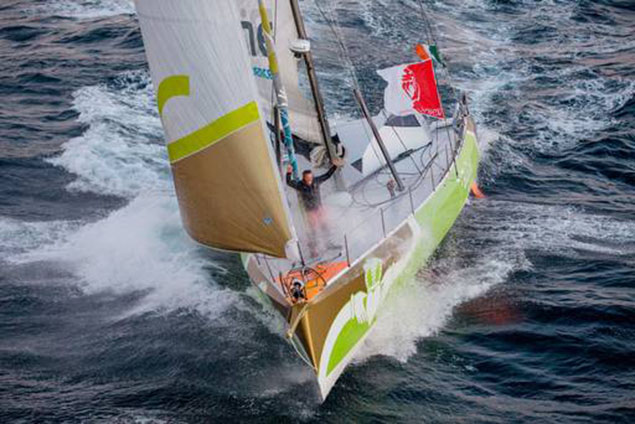 Still racing. If the rate of attrition among other entries persists and his speed continues to improve, Enda O Coineen’s Kilcullen Voyager could finish in single figures in a race in which 29 started. Photo Team Ireland
Still racing. If the rate of attrition among other entries persists and his speed continues to improve, Enda O Coineen’s Kilcullen Voyager could finish in single figures in a race in which 29 started. Photo Team Ireland
Thus the really stupendous thing is that Enda O Coineen may be all of 5700 miles astern of the leader, yet we still feel he is very much racing. He is currently placed 13th overall, and he has it in him to move into single figures if the current rate of attrition persists, and he continues to show his guts and ingenuity in overcoming problems. His best day’s run – 395 nautical miles – was recorded as recently as December 9th.
Enda O Coineen arouses mixed feelings in those who have interacted with him in times past, but he has rightly endeared himself to the world, - and the Irish public in particular – with his tales of life on board the Kilcullen Voyager, and his delight in breaking into poetry at every opportunity. When the distinguished Tyrone-born poet John Montague passed away recently, Enda was right there with a reading from the great man’s works. But perhaps the most abiding member of this race will be from a sunny time when the going was good and Enda felt – with every justification – that the joys of the day merited a sunlit reading of Joseph Plunkett’s A Wave of the Sea, which certainly deserved it:
Kilcullen Voyager has even experienced poetry sessions
I am a wave of the sea
And the foam of the wave
And the wind of the foam
And the wings of the wind.
My soul’s in the salt of the sea
In the weight of the wave
In the bubbles of foam
In the ways of the wind.
My gift is the depth of the sea
The strength of the wave
The lightness of foam
The speed of the wind.
Now here in Ireland we are going through one winter storm after another, but the fishing boats are crowded safely in port, the Christmas homecoming flights have finally made it, and peace moves in on the land. It isn’t until Monday that the fleet races away down Sydney Harbour. Yet far out in the Southern Ocean and immediately past Cape Horn, those tiny specks are the Vendee Globe boats racing on through Christmas Eve, through Christmas Day, through everything. We wish them well, and wish everyone a very happy Christmas.
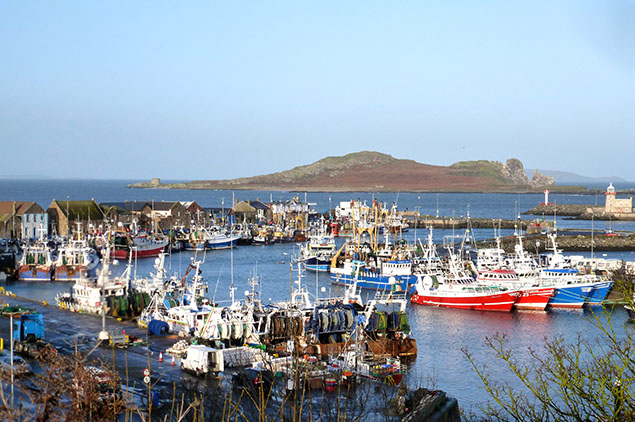 It’s Christmas, and the fishing fleet is safe in port. Howth as it was yesterday afternoon. Photo: W M Nixon
It’s Christmas, and the fishing fleet is safe in port. Howth as it was yesterday afternoon. Photo: W M Nixon
Le Cléac'h Leads Vendee Globe at the Horn
Armel Le Cléac'h is expected to lead the eighth edition of the Vendée Globe solo round the world race around its most feared but most universally welcomed landmark, Cape Horn, tomorrow around midday. The French skipper should pass the notorious southernmost tip of South America with the biggest lead since January 2001 when Michel Desjoyeaux led English skipper Ellen MacArthur by some 600 miles.
That over the ensuing seven days Desjoyeaux's lead over MacArthur in early 2001 was cut to some 140 miles in the sticky South Atlantic high pressure system, as that edition of the race effectively re-started there, will continue to give hope to second placed Alex Thomson on Hugo Boss. The only British skipper in this race struggled today with a very disorderly small low pressure cell which has slowed him still more while Le Cléac'h has remained relatively speedy. At 595 miles behind Banque Populaire VIII Thomson may find himself racing upwind, albeit on his favoured starboard tack tomorrow before finally making back some ground after Le Cléac'h passes the Horn.
3rd in 2008-9, 2nd in 2012-13, 1st in 2016-17?
For Le Cléach it will be the third time in successive editions of the Vendée Globe that he has rounded the Horn in the top three. In 2008-9 he was third behind Roland Jourdain and eventual winner Michel Desjoyeaux. And in the last edition he was just two and a half hours behind victor François Gabart. In the 2004-5 race Vincent Riou lead Jean Le Cam around Cape Horn by 15 hours and went on to win. Desjoyeaux led Roland Jourdain in early 2009 by nine hours and won the race ahead of Le Cléac'h after Jourdain's keel bulb dropped off south of the Azores.
After Alex Thomson established a new record for the stage from Les Sables d'Olonne to the Cape of Good Hope, on 24th November, some five days and one hour faster than the mark set in 2012 by Le Cléac'h, there looks set to be little in the way of significant net gain or loss on that advance since. A relatively fast Indian Ocean has been followed by a passive, complicated Pacific and so Le Cléac'h seems likely to pass in somewhere around 47 days. On this schedule Le Cleach should reduce the record of Francois Gabart by a matter of five days and some hours. At this same time on the first day of 2013, Gabart had slashed four days and nine hours off his mentor Michel Desjoyeaux's mark set in January 2009. Thomson will be buoyed by the expectation that the weather after Cape Horn does finally look a little more complicated for the race leader, who has enjoyed particularly smooth, assured transition periods, not least managing to multiply a margin of some 15 or so miles to the comfortable cushion he looks set to round Cape Horn by Armel Le Cléac'h.
SMA Solution
Paul Meilhat, who lay in third place, continues to plough a forlorn furrow northwards into lighter winds after his keel ram cracked. His team have found a solution, a replacement from Maître CoQ, the sistership which the SMA skipper spent 25 days racing alongside, and which raced as Le Cléach's Banque Populaire in 2012, duelling around the globe with MACIF which is the compromised SMA. Their plan seems to be to send a team to fit the replacement ram and SMA continue her course unclassified.
After a few very fast days on his foils since passing New Zealand Jean-Pierre Dick - who finished fourth in the last edition, is now up to fourth and 270 miles ahead of his closest rivals. But he has run into a ridge of high pressure. Yann Eliès (Queguiner-Leucémie Espoir) and Jean Le Cam (Finistère Mer Vent) have regained around thirty miles on JP Dick, while Jérémie Beyou (Maître CoQ) has accelerated. The South Pacific has its ups and downs, winners and losers, but this morning's life enhancing consolation for JP was a pod of dolphins dancing around his boat.
The race is close again too for the group of five entering the South Pacific. The youngest competitor in the fleet Alan Roura, 23-years old, with his boat which dates back to 2000 keeping up with four IMOCAs from the 2007-2008 generation. They are all within 145 miles of each other with Eric Bellion (CommeUnSeulHomme) still keeping his foot hard down. Over the past 48 hours, the 40-year old racing the powerful Finot Conq designed former DCNS, who sees the Vendée Globe as his big adventure has been the fastest in the fleet clocking up 400 miles a day and averaging 17 knots.
Four hundred miles from Melbourne, Australia, Stéphane Le Diraison the skipper of La Compagnie du Lit-Boulogne Billancourt has run into a wind hole. This is tough for the skipper, who was only making 4.5 knots when he had thirty knots of wind. Le Diraison has had to use his DIY talents to improve his jury rig. “I had kept around a ten square metre piece of the mainsail after the boat was dismasted. I have become a sail maker setting up a mainsail suitable for my rig. It's been successful. I have managed to raise my jury rig and now I have a bit more sail up. I shall be able to sail higher when I have headwinds. Otherwise there was the risk of ending up back where I started.”
Enda O'Coineen Lying in 14th Place in Vendee Globe But Computer Black Out Leaves Him (Almost) Out of Touch at Cape Leeuwin
Ireland's first ever Vendee Globe racer Enda O'Coineen is in 14th Place as the 27–boat round–the–world fleet as it passes another major milestone, Cape Leeuwin, the most south-westerly mainland point of the Australian Continent. But computer problems have left the Galway Bay solo sailor largely out out of touch and reliant on satellite phone. Here on Day 44/45, he updates Aflaot.ie readers from the Kilcullen Voyager:
'Our human capacity to adjust to new realities is amazing, whatever that may be. Like losing an arm, or a leg, or in my case computer navigation system. Something you thought you could not do without.
Now I’m nervous and afraid. As we go along the bottom of Australia and prepare for the vast unknown of the South Pacific before it meets the Antarctic. It’s also disturbing to hear that in recent days we have lost two, possibly three more boats. One due to a collision, one losing a mast, and most recently our friend Paul Meilhat of SMA with a keel hydraulic problem.
But at least there is my surprise Christmas package to look forward to on day 50 at sea. It should be somewhere south of Tazmania – though I confess to digging into the Chocolates last week during one of the storms.
After our backup system failed to work I was disorientated. I said I could not continue, particularly with the internet connection to the outside world, no weather information, news on other boats and so forth.
Now a few days later I have readjusted to the new reality and back in our “chart” around the planet. The outside world will also be spared from pictures and videos of the SORA President Elect and all the antics on board the good ship Kilcullen.
While the race is secondary to completing the objective of finishing and promoting our sponsors and the Atlantic Youth Trust. Nonetheless there is a strong desire to be in there, stay with the group, and have a respectable placing to do justice to the flag, team and boat.
There was a quiet satisfaction in passing Rich Wilson the other night on Great American IV. A deep thinking brilliant man, he has a degree in mathematics from Harvard and MIT and an impressive schools programme with 300,000 kids following his adventure.
Meanwhile rather than looking at what is not working, looking at what I have is a satellite phone, and a boat that’s functioning and we have a GPS position and paper charts. Also the race committee will allow us to get weather information by phone. We’re also constantly looking to find solutions and make do with what we’ve got. Also on the positive side with the exception of reefing problems on the main (which is very important in storms), the rest of our ship is in good shape and my daily routine and maintenance programme is never ending.
Finally, I learnt of a message from a young follower in Paris today, Milos. Sadly I'll have to wait until my computer is back up and running to see the card but thank you. It's somewhat strange to think you're all at home following this adventure and I can assure you it means a lot to me. The complexity of getting these logs to you is now greatly increased but I will endeavor to keep it up'
Enda O'C



























